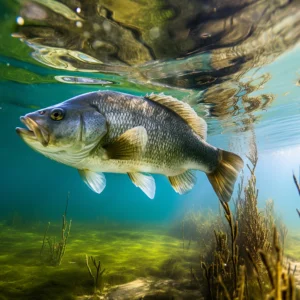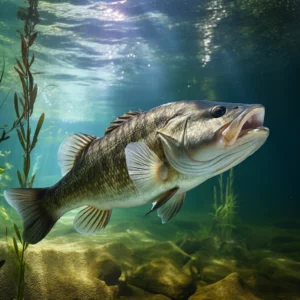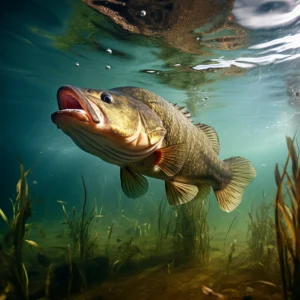What makes the black bass fish so intriguing? Have you ever wondered about its characteristics and behavior? In this article, we will explore everything you need to know about the black bass fish, from its physical appearance to its habitat and feeding habits. By the end, you’ll have a comprehensive understanding of this fascinating species.
The black bass fish, also known as the Micropterus species, consists of various types of bass, including the largemouth bass and smallmouth bass. These fish are highly sought after by anglers due to their great strength and fighting spirit when caught. In terms of physical appearance, the black bass is easily recognizable by its elongated body, dark green or brown coloration, and a lower jaw that extends beyond the back of its eye.
Now, let’s dive into the details. Black bass are found in freshwater environments such as lakes, rivers, and reservoirs, where they prefer areas with ample cover like vegetation, logs, and submerged structures. They are ambush predators, meaning they hide and wait for their prey to come close before striking. Their diet mainly consists of smaller fish, crustaceans, insects, and even small mammals at times.
In the upcoming sections, we will delve deeper into the black bass fish’s feeding behavior, reproductive habits, and the best techniques for catching them. So, if you’re interested in learning more about this popular game fish, keep reading to become a black bass expert! Black bass fish is a popular freshwater species that is highly sought after by anglers and esteemed for its sport fishing qualities. It belongs to the Centrarchidae family and is native to North America. The black bass fish is known for its aggressive nature, making it an exciting catch for fishing enthusiasts.
Overview of black bass fish Black bass fish, also known simply as bass, is a type of fish that encompasses several species, including largemouth bass, smallmouth bass, spotted bass, and redeye bass. These species have similarities but also distinct characteristics that set them apart.
Physical characteristics of black bass fish Black bass fish generally have elongated bodies with a slightly compressed shape. They possess a large mouth, which is the feature that gives the largemouth bass its name. The mouth of the smallmouth bass is smaller in comparison. The coloration of black bass fish can vary, but they commonly have a dark hue, which helps them blend into their surroundings. Largemouth bass can have a greenish-black color, while smallmouth and spotted bass may exhibit a bronze tone.
Habitat and distribution of black bass fish Black bass fish are primarily found in freshwater habitats such as lakes, rivers, ponds, and reservoirs. They prefer areas with submerged vegetation, fallen trees, and rocky structures where they can hide and ambush their prey. Black bass fish are native to North America and are predominantly distributed in the United States, particularly in the eastern and central regions. They have also been introduced to other parts of the world, including Australia, Europe, and Asia, where they have established populations.
Diet and feeding habits of black bass fish Black bass fish are opportunistic predators that feed on a variety of prey. Their diet consists of smaller fish, insects, crayfish, amphibians, and even small birds or rodents that may fall into the water. Black bass fish are known for their voracious appetite and their ability to strike their prey with remarkable speed and precision. Largemouth bass are especially known for their ability to inhale large prey items due to their expansive mouth.
Reproduction and lifecycle of black bass fish Black bass fish reproduce through spawning, which occurs when water temperatures reach a certain threshold. Typically, the spawning season takes place in the spring and early summer. The male bass builds a nest in shallow water, often near vegetation or other structures. The female bass lays her eggs in the nest, and the male fertilizes them. The male then guards the nest and protects the eggs until they hatch. The newly hatched bass fry stay close to the nest and are also protected by the male. As they grow, they venture out into deeper water and become independent.
Types of black bass fish Largemouth bass: The largemouth bass (Micropterus salmoides) is the most well-known species of black bass fish. It is characterized by its large mouth that extends beyond the eye, hence the name “largemouth.” Largemouth bass can reach impressive sizes, with some individuals exceeding 20 pounds in weight. They are known for their strength and ability to put up a challenging fight when caught.
Smallmouth bass: The smallmouth bass (Micropterus dolomieu) is another popular species of black bass fish. It is distinguished by its smaller mouth and a coloration that is usually brown or bronze. Smallmouth bass prefer clear and rocky waters, such as rivers and streams. They are highly regarded for their acrobatic leaps and powerful runs, making them a favorite target for anglers.
Spotted bass: The spotted bass (Micropterus punctulatus) closely resembles the largemouth bass in appearance. It has a similar coloration, but with distinct dark spots on its sides. Spotted bass are native to the southeastern United States and are known for their aggressive feeding behavior. They can reach sizes comparable to largemouth bass but are generally smaller on average.
Redeye bass: The redeye bass (Micropterus coosae) is a lesser-known species of black bass fish. It is primarily found in rivers and streams of the southeastern United States. Redeye bass have a reddish tint on their fins and tail, giving them their name. Although smaller in size compared to other black bass species, they are known for their vibrant colors and their willingness to hit a variety of lures.
Identification of black bass fish Distinctive features: Black bass fish can be identified by their physical characteristics, which include an elongated body, a large mouth (in the case of largemouth bass), and a dark coloration that helps them blend into their environment. They also have a dorsal fin, which is typically divided into two parts, a spiny portion and a soft portion.
Coloration and markings: The coloration of black bass fish can vary depending on the species and habitat. Largemouth bass often have a greenish-black color on their backs and sides, fading to a lighter shade on their belly. They may also display dark stripes or blotches along their sides. Smallmouth bass usually have a bronze or brown color, with vertical dark bars on their sides. Spotted bass have a similar appearance to largemouth bass, but with distinct dark spots scattered across their sides. Redeye bass have a reddish tint on their fins and tail, along with subtle bars on their sides.
Size and weight variations: Black bass fish can exhibit a wide range of sizes and weights based on factors such as genetics, habitat quality, and food availability. Largemouth bass are known for their potential to grow to large sizes, with some individuals reaching weights exceeding 20 pounds. Smallmouth bass are generally smaller, with most individuals ranging from 1 to 5 pounds. Spotted bass and redeye bass fall somewhere in between, with average sizes ranging from 1 to 3 pounds.
Fishing for black bass Popular fishing techniques: Fishing for black bass can be an exhilarating experience, and there are various techniques that anglers employ to increase their chances of success. Some popular methods include casting and retrieving lures such as plastic worms, crankbaits, and topwater baits. Jigging, flipping, and pitching techniques are also effective in specific situations. Additionally, using live bait, such as minnows or crayfish, can entice black bass to bite.
Tackle and equipment: Selecting the right tackle and equipment is crucial for black bass fishing. Anglers commonly use medium to heavy action spinning or baitcasting rods with matching reels. The choice of fishing line depends on the technique used, but monofilament or fluorocarbon lines with suitable pound-test ratings are typically employed. Black bass are known for their powerful runs and dives, so it is essential to have strong and reliable fishing gear to handle their strength.
Best fishing spots: Black bass fish can be found in a variety of freshwater habitats, but some locations are particularly renowned for their bass fishing opportunities. Lake Okeechobee in Florida, Lake Fork in Texas, and Lake Guntersville in Alabama are just a few examples of popular bass fishing destinations. Rivers and streams with clear water and rocky structures also attract smallmouth bass enthusiasts. Local fishing guides and online resources can provide information on the best fishing spots in specific regions.
Tips for successful black bass fishing: To improve your chances of success when fishing for black bass, keep the following tips in mind:
- Study the behavior and feeding patterns of black bass fish in your target area.
- Use the appropriate fishing techniques and lures based on the prevailing conditions.
- Pay attention to the weather, as black bass fish may be more active during certain times of the day or under specific weather conditions.
- Practice catch and release to help maintain healthy fish populations and ensure sustainable fishing opportunities.
- Explore different areas and experiment with various lure presentations to find what works best.
Conservation and management Importance of black bass fish in ecosystems: Black bass fish play an essential role in freshwater ecosystems. As opportunistic predators, they help control populations of smaller fish, insects, and other aquatic organisms. Playing their part in the food chain, black bass fish contribute to the overall balance and health of their environments.
Threats and challenges to black bass populations: Despite their widespread distribution and popularity, black bass populations face several threats and challenges. Habitat destruction, pollution, overfishing, and the introduction of invasive species can negatively impact black bass populations. Climate change and its associated effects, such as rising water temperatures and altered precipitation patterns, also pose risks to their survival.
Conservation efforts and regulations: To protect black bass populations and ensure their sustainability, various conservation efforts and regulations are in place. Catch limits, size restrictions, and fishing seasons are implemented to prevent overfishing and allow populations to replenish. Additionally, habitat restoration projects, water quality management, and the promotion of responsible fishing practices contribute to the conservation of black bass fish.
Role of anglers in maintaining sustainability: Anglers play a crucial role in maintaining the sustainability of black bass fish populations. By practicing catch and release, following fishing regulations, and actively participating in conservation initiatives, anglers can contribute to the long-term health of black bass populations. Educating themselves and others about responsible fishing practices also helps raise awareness and promote sustainable fishing opportunities.
Black bass fishing records All-time largest black bass catches: Over the years, numerous anglers have achieved remarkable catches of black bass, some of which have set records and garnered attention in the fishing community. While individual records may vary depending on the species and location, the largest catches of black bass have surpassed the 20-pound mark.
State and world records: Different states have their own records for the largest black bass catches within their jurisdiction. The International Game Fish Association (IGFA) also maintains world records for various species, including black bass fish. These records serve as benchmarks and sources of inspiration for anglers seeking to land their own record-breaking catch.
Notable fishing achievements: Apart from official records, there have been notable fishing achievements involving black bass fish. Anglers who consistently excel in tournaments or demonstrate exceptional skills and knowledge of black bass fishing techniques become recognized figures within the angling community.
Health benefits of consuming black bass fish Nutritional value of black bass fish: Black bass fish provide a good source of essential nutrients. They are low in fat and calories, making them a healthy choice for those seeking a nutritious and balanced diet. Black bass fish are a good source of protein, vitamins, and minerals, including vitamin B12, selenium, and omega-3 fatty acids.
Omega-3 fatty acids and heart health: Omega-3 fatty acids are polyunsaturated fats that are beneficial for heart health. Black bass fish, particularly the smallmouth and largemouth bass species, are a natural source of omega-3 fatty acids. Regular consumption of black bass fish, as part of a healthy and balanced diet, can contribute to the prevention of heart disease and support overall cardiovascular health.
Other potential health benefits: In addition to omega-3 fatty acids, black bass fish may offer other potential health benefits. Some studies suggest that consuming fish rich in omega-3 fatty acids may have anti-inflammatory effects, improve brain function, and reduce the risk of certain chronic diseases such as arthritis, depression, and Alzheimer’s disease. However, more research is needed to fully understand the extent of these benefits.
Culinary uses of black bass fish Popular cooking methods: Black bass fish can be prepared and cooked in various ways, allowing for a wide range of culinary options. Grilling, baking, broiling, and pan-frying are common cooking methods that help preserve the natural flavors and textures of the fish. Black bass fish can also be used in soups, stews, and fish tacos.
Recipes and dishes featuring black bass: There are countless recipes that showcase black bass fish in all its glory. Some popular dishes include blackened bass, baked bass with lemon and herbs, bass ceviche, and bass chowder. The versatility of black bass fish allows for creative and mouthwatering recipes that cater to various tastes and preferences.
Tips for selecting and preparing black bass: When selecting black bass fish for cooking, look for fresh specimens with bright eyes, firm flesh, and a pleasant smell of the sea. If caught yourself, ensure proper cleaning and storage to maintain freshness. When preparing black bass, remove any bones and scale the fish before cooking. Season the fish according to your taste preferences, and cook it to the desired doneness, being careful not to overcook and dry out the meat.
Interesting facts about black bass fish Unusual behaviors and adaptations: Black bass fish exhibit several interesting behaviors and adaptations. For example, largemouth bass have the ability to change their coloration to match their surroundings, making them highly camouflaged predators. Smallmouth bass are known for their ability to use their muscular bodies to navigate strong currents and capture prey in fast-flowing rivers.
Cultural significance: Black bass fish hold cultural significance in various regions, particularly in the United States. They are emblematic of recreational fishing and are often associated with outdoor traditions and the enjoyment of nature. Bass fishing tournaments and events that celebrate the sport attract enthusiasts from all walks of life.
Famous black bass fish sightings: Certain black bass fish have gained fame due to their impressive size or unique markings. These fish often become local legends and draw attention from anglers and enthusiasts. While rare, sighting and encountering such notable black bass fish can create memorable experiences and fuel the excitement of passionate fishermen.
Conclusion In conclusion, the black bass fish is a captivating and highly valued species that has become a favorite among anglers. Its aggressive nature, impressive size, and challenging fight make it a prized catch for fishing enthusiasts. Understanding the overview, physical characteristics, habitat, diet, and reproduction of black bass fish provides valuable insight into the species.
The different types of black bass, including largemouth bass, smallmouth bass, spotted bass, and redeye bass, offer diverse fishing experiences and opportunities across various regions. Identifying black bass fish based on their distinctive features, coloration, and size variations allows for accurate recognition and appreciation.
Effective fishing techniques, proper tackle and equipment, and knowledge of the best fishing spots contribute to successful black bass fishing adventures. Conservation efforts and responsible fishing practices are crucial for maintaining the health and sustainability of black bass populations.
The nutritional value, omega-3 fatty acids, and potential health benefits of consuming black bass fish highlight its importance in a balanced diet. Culinary uses ranging from grilling to baking showcase the versatility and deliciousness of black bass. Interesting facts about black bass fish, including their behavior, cultural significance, and famous sightings, add intrigue and fascination to their captivating nature.
In conclusion, the black bass fish is a remarkable species that deserves appreciation, exploration, and conservation. By understanding and respecting the beauty and importance of black bass fish, we can ensure the continued enjoyment and conservation of their habitats for generations to come.




